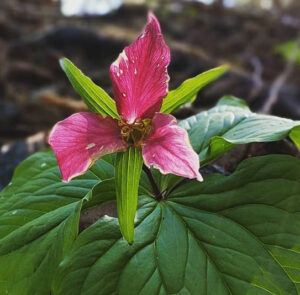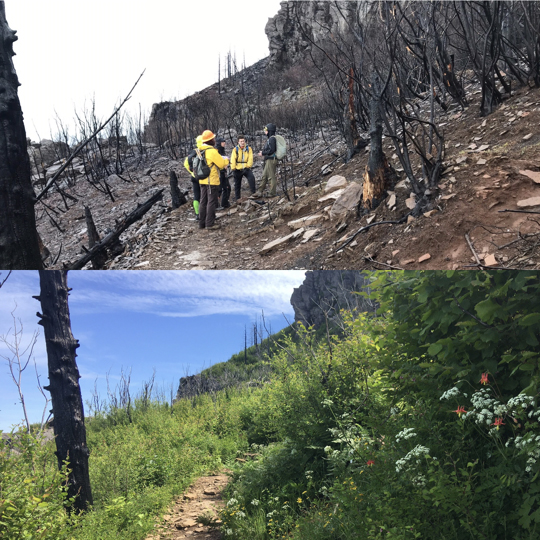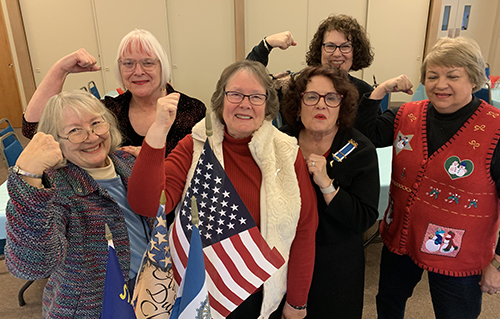“The question – what happens after a fire? – is an important question,” retired US Forest Service Fire Ecologist Jane Kertis said when asked about 2020’s Beachie Creek Fire. It, along with the Lionshead Fire, burned through the Santiam Canyon last Labor Day leaving many favorite parks still closed for recovery.
Kertis thinks the question of how different types of land recovers from wildfire is so important that she based the entirety of her 30-year career on discovering the answer.
“People tend to think, when they think of fire, a charred moonscape,” she said of the view of wildfires most often portrayed in the media. “But there’s not really going to be much of a moonscape very long.”
That’s largely because, on the heels of a fire, plants and animals almost immediately move back into the landscape – foraging for food and making their homes in newly changed spaces.
“I’ve never seen so much wildlife as I have doing film and photography in burned landscapes,” Ralph Bloemers said. He’s a strategic advisor with the Crag Law Center, working with firefighters, conservationists and community groups affected by wildfire.
“I’ve done photography in Yellowstone and in the Siskiyous, all in burnt landscapes. Even in the Elkhorn area, which was burned to a crisp, I’ve already picked up elk and rabbits.”
For grazing wildlife, such as elk, burned areas offer the chance to graze on tender vegetation no longer shaded out by trees.
“Ungulates – or grazing animals – really appreciate that because there’s not as much to eat in an enclosed forest than an open canopy forest,” Amanda Rau confirmed. She is a fire specialist working with the OSU Extension Service in the Willamette Valley and North Cascades. Although wildlife is certainly impacted when a wildfire sweeps through, “the net benefits generally outweigh the negative impact,” she added.
This is especially true for many species of birds, some of which nest exclusively in charred trunks, while others hunt for the bugs or small rodents no longer hidden by overhanging branches.
“The high severity expression, that’s awesome for birds and for the nutrients that the dead trees provide,” Kertis noted. “It’s all good from an ecological perspective. I think it’s really from that social perspective that we (say) that this is bad or this is good.”
But separating the ecological from the social is nearly impossible, especially in areas – like the Santiam Canyon – where forest landscapes are side-by-side with communities.
“As much as I talk about this being a natural thing, that doesn’t take away what effect this had on people,” Rau said. She visited sites affected by the Beachie Creek Fire in October 2020, and again in mid-March 2021.
“It’s hard to see that town (Detroit) and realize what happened there. My heart’s there and I really feel for the people that were impacted.”
Raised on the McKenzie River, fire came within a mile of Rau’s childhood home, forever changing the familiar forests she had hoped to one day share with her son.
“I had to do my own grieving around that,” she admitted, venturing that her reaction is not uncommon, even amongst scientists.
“I think certainly from an aesthetic standpoint it’s possible to look out there and not see the good because we’re used to an intact forest,” she pointed out. “But wildlife benefits a lot from wildfires like these.”
And many trees benefit, too – though at first glance that can be difficult to see.
“Some of the work people have done is look at tree rings to get an idea of past fires,” Kertis noted. Explaining that a tree’s rings will often show a wider growth record during post-fire years, due to an influx of nutrients on the forest floor.
“What we’ve seen from the past is that in these really intense fire periods, that’s when you have your pulses of Douglas fir,” Kertis gave as one example of a species well adapted to sporadic fires. “And that’s not an unnatural response to big intense fire. Douglas fir is very well adapted to regenerate in open, burned areas.”
“People say, we need to go out there and plant,” Bloemers said of the instinct many landowners have to immediately repair what was burned. “They don’t. Even if you look at the arial for the Opal Creek Drainage, you’ll see the trees that look like a blackened stick but they have cones on them and the birds will spread them everywhere.”
And with a newly opened canopy, those seeds, as well as many others, will thrive.
“In places where you had those high severity fires, where it killed everything, you may have Douglas fir come back and regenerate,” Kertis said. “And you might see that next year, depending on how close a Douglas fir tree is to the site. You’ll also start to see some of the under story coming back – rhododendron, vine maple, those are all adapted to fire because they have the ability to sprout after a disturbance. You also might see fire weed. It’s called fire weed for a reason. It’s got seeds that travel far and fast.”
In places where lower intensity fire moved through, where the under story was removed but the trees were left largely unharmed – that’s where the fastest healing takes place.
“You might start seeing some trees that looked like they were pretty well charred coming back to life,” Kertis said. “Oregon white oak, big leaf maple, Douglas fir – it’s almost like the plants are kind of shaking themselves and saying, ‘That’s only a scratch.’ Same thing with the herbs and shrubs. They’re going to be coming back. They might look a little funny at first but they’re very well adapted.”
The difficulty, Bloemers speculated, lies in having the patience to wait the many years it takes for nature to rebuild what the fire has seemingly taken away.
“We love these places because they’re wild and created in disturbance, yet we mourn when they change as we know them,” Bloemers said. “For our own wants we want them to be static and they never will be.”
Nor should they be, especially with global warming making it more necessary than ever for plants to adapt.
“From a climate change perspective, it’s a time of change but it’s also a time for a kind of shift in a plant perspective,” Kertis confirmed. “Douglas fir live to be 1,000 years old – that’s a long time to wait for things to change – so, fires play a role in that change.”
Already Rau is observing a southern shift in planting zones and councils those who are planning on replanting lost trees to take these changes into account.
“Knowing we are entering into, or are in the midst of, a warm dry period and knowing that it’s important to select species that will survive, if you’re thinking about planting and you want to see things that might do well, you might look south,” she said. “Some of the species that folks are planting are incense cedar, sugar pine, giant sequoia and redwood. And hardwoods such as oak are being considered as well.”
Another reason to think beyond replacement when deciding what to plant is the current shortage of tree seedlings. Nurseries throughout Oregon are struggling with supplies due to the requirement that private landowners who are salvage logging replant removed trees within two years.

“We estimate there might be a need for 100 million seedlings right away – based on the acreage that was so severely burned,” Glenn Ahrens, an OSU Extension Service Forester working with private landowners, said.
“In a normal year we might replant 40 million trees. So, if they’re not in the business and have already ordered seedlings, where are they going to get the trees? The nurseries did not plan for this.”
Planting seedlings can be problematic in other ways as well, according to Kertis. “The problem with salvage logging huge plots and planting one species is you’re putting all your eggs in one basket. Just like with crops, if you put all your money in crop A and all of a sudden, an insect comes and destroys the crop… that’s a problem.”
The answer, according to Kertis, lies in maintaining diversity. It can be a real challenge, she acknowledged, when people live, work and recreate, all within the forest landscape.
“We can’t create these resilient landscapes in a vacuum,” she said. “Timber lands need to work with national forest lands and private landowners to create these resilient landscapes. You have to collaborate with your neighbors because of the way fire moves through. I think it takes a paradigm shift. But I think it takes these kinds of disturbances to get people open to thinking about it.”
The bottom line is, we can’t suppress all fires, nor should we, according to Rau. “The people who lived in the Willamette Valley prior to colonization were very comfortable with fire and didn’t put it out. And although a lot of indigenous practitioners are very aware of the destructive nature of fire, there’s a respect for fire and that’s a lot different than fearing it.
“I encourage people to develop a respect for fire and look to the people who have lived a lot longer on the landscape than us.”
“It’s becoming more clear that something has to happen,” Kertis agreed. “And we need to look to the past and we need to look to the future in terms of making those decisions. Because you have a group of people who are looking back and saying this is what was. And you have a group looking at the future and saying – Ah! You need a group of people looking at both.
“We knew fire was an important process and we think fire needs to be an important part of the system. But it’s not just as simple as reintroducing fire…
“It’s going to take dedication and open minds and paradigm shift to think about future, resilient landscapes. We all have to work together to be successful.”

